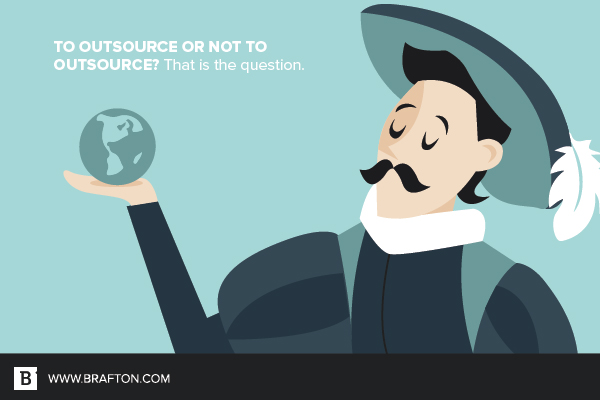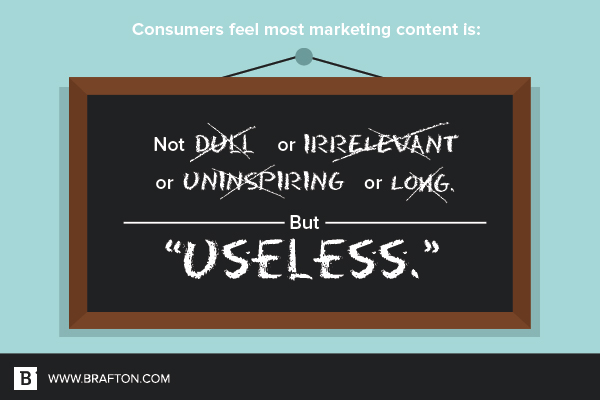To outsource or not to outsource? That is the question. This question besieges the minds of modern CMOs as they pace up and down their corridors ardently figuring out how to better promote and grow their companies through effective content marketing campaigns.
It’s not always easy to answer. Partly because – as so often in life – there is no simple response.
Marketing is inherently messy, complex, awash with inputs, and riddled with imprecision. Content marketing – a key aspect of any successful marketing campaign – displays all these unruly tendencies, and more.

But do not despair, dear CMOs, because the prize is glittering for those who prevail. Your approach to content marketing needn’t be an either/or between in-house and outsource.
The trick is to achieve the right balance between the two as fits the particular needs of your company at any point in time.
Getting it right
Outsourcing done well develops into a healthy partnership between client and content marketing agency. Your content marketing partner will come to understand aspects of your business better than you do. Yes that’s right – better than you.
Can that really be possible? Well, consider this: According to a recent Forrester report, 4 out of every 5 senior marketers believe their companies produce content that their customers and prospects value.
Which is another way of saying they have a high opinion of their own work.
Beware groupthink
Who can blame them really? Doesn’t it feel great to sign off on a deliverable that your in-house teams have worked hard to complete. It’s collaboration at its best, with everyone stepping up to the plate to create standout collateral.
So good, in fact, you’re prepared to overlook the fact that the creative lacks a little inspiration. That the concept is not entirely grounded in buyer-side research. That the video runs a little long. Who wants to rain on the parade?
But what about your customers and prospective buyers? How do they feel about your content?

According to Forrester, the response is loud and clear. At least 50 percent of people surveyed said the majority of brand-produced content was “useless.”
Not dull or irrelevant or uninspiring or long. But “useless.”
“Marketers seem to be slowly recognizing the painful truth about their own content skills,” declares the report.
And that should be a wake-up call to CMOs everywhere.
Avoiding oversimplification
It’s not that in-house content creation is invariably flawed. Many large brands see the value in having greater direct control over their content marketing apparatus.
Take Intel. Teresa Herd, the company’s global creative director, joined Intel from Staples, where she was instrumental in setting up an internal agency.
Agency Inside, was her flagship initiative at Intel. Through this internal agency approach, she built up Intel’s internal creative team and vested it with the kind of outside mentality that traditional agencies are charged with bringing to the table.
“When I came to Intel, there was not an Agency Inside,” Herd told Marketing Land. “I’ve been here going on two and a half years, and we probably did 96 percent of our work with external agencies — we did a little bit in-house, we had a small production team — but, other than that, it was executed by external agencies.”
Today probably 65 to 70 percent of the work is done in-house, and the balance is picked up by outside firms.
Diego Scotti, CMO at Verizon, is taking a similar approach. He recently hired Andrew McKechnie from Apple to head up a new in-house agency at the telecom giant. But it’s not “in-house or nothing” for Scotti. He continues to see the value in outside agency partnerships.
Addressing the ANA Masters of Marketing conference this past fall, he refuted suggestions the agency model is broken.
“Don’t be afraid to hire someone who you disagree with,” Scotti said. “Your ego may take a hit in the short term, but I promise you that you’re smart even if there’s no one there to tell you that every day.”
Weighing everything up
In-house certainly has its attractions. Agency-produced content is not necessarily more effective in the marketplace. Agencies can become lazy and not challenge themselves or their clients.
By the same token, building an in-house team requires a serious investment of time and money. Most companies do not have the deep pockets of Intel or Verizon. An outside agency can help build your content marketing capabilities and ensure you are getting good ROI from your marketing spend.
Either way, it isn’t easy. Brand publishing has never been more challenging or more important to get right.
So let me return to the question I opened with: To outsource or not to outsource? There actually is a simple response. Do both.
7 is the magic number
So what does this mean in practice? I advocate a seven-point approach, broken into various stages of review and adjustment:
- Review your quarterly and yearly business goals with your executive team. Are you unambiguously clear on what you are striving to achieve as a company for the coming 12 months?
- Review and adjust your marketing goals in light of your business objectives. Remember sometimes the marketing goal is the business goal, particularly when you’re focused on a heavily inbound play.
- Review your internal marketing resources and existing areas of expertise. Where are you already well-covered by your in-house people, and where do you lack sufficient expertise?
- Review your existing collateral and core marketing architecture. Run a content audit on your website, inspect your core landing pages and assess your company’s UX across all device and platforms. Evaluate your overall social presence, your paid campaigns and your brand visibility across your target audience. Do you have your buyer personas down?
- Review your existing agency relationships and map them against your in-house capabilities. Keep new agency partnerships under continual review.
- Adjust and finalize your marketing plan, including concrete goals and metrics. Be clear about who from your in-house team is assigned which aspect of the plan and how they will be held accountable for its performance.
- Ensure that a documented content strategy is part of your overall marketing plan, and that specific campaigns are highlighted and calendared within. Earmark those areas of the plan where you would specifically benefit from agency input and guidance.
Once you have gone through this exercise, you should have a pretty clear idea how best to marshall your internal resources and where exactly to bring in external support.
As part of your planning, I advise you find a full-service content marketing agency that is familiar with your space but most importantly understands how all aspects of a well-balanced marketing strategy works.
Take them through your seven-point checklist, seek their input, and foster agreement around how they can best sync with your in-house capabilities and your overall marketing plan.
Trust begets trust
If you are looking to enlist an agency on a specific element of your plan and don’t feel the need to let them into the broader picture, that can work as a tactic – at least temporarily. However, don’t hold them at arm’s length for too long.
Remember the more context you give your content marketing agency, the greater trust you will build with them and the stronger the results will eventually be.
And from there will grow the foundations of a beautiful relationship. Messy at times, fraught with imprecision, subject to disappointments and occasional frustration, complex in practice, simple at heart, but trusting and supportive and built for the long term. Just like a good relationship should be.
Check out the rest of the Leading Edge series for more insights into the digital marketing industry.




